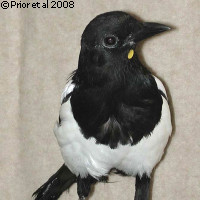Magpies identify themselves in a mirror
A German study published in PLoS Biology on Tuesday reported that magpies, like some apes, dolphins and elephants, have the ability to recognise themselves in a mirror. These findings support the idea that recognizing one's self is not an attribute exclusive to 'higher mammals' and, moreover, that the mammalian brain's neocortex is not a prerequisite for self-awareness, as previously thought. Magpies, like jays, are birds that store food, remember where they put it and remember which of their friends saw them put it there. This indicates a fairly high level of social understanding and suggested to psychologist Helmut Prior of Frankfurt University and colleagues that magpies (and other large-brained birds) might have other advanced cognitive abilities, such as empathy and perspective taking. Because these qualities are believed to coevolve with mirror self-recognition, they studied a group of magpies studying themselves in a mirror. The mirror self-recognition test isn't as simple as putting an animal in front of a mirror and watching it attack or court the image: a visible mark is placed somewhere on the animal where it can't be seen without looking in the mirror, and the animal's reaction to seeing the mark is recorded. In the current study, a brightly coloured mark was placed on the black feathers under the beak; the magpies would react to seeing the mark by scratching or exploring it. (They had no reaction to a black mark put in the same place, confirming that they weren't just irritated by the paint.) The magpies' reaction to the mark showed that they knew the image in the mirror represented themselves and not another bird. It has been generally accepted that in mammals (and humans in particular), the part of the brain called the laminated neocortex is responsible for the recognition of self. Self-recognition in magpies is, therefore, surprising because the forebrain structures of birds and mammals diverged evolutionarily about three million years ago, and birds did not develop a laminated neocortex. So if both mammals and birds can experience self-recognition and empathy, this would mean that these elaborate cognitive skills developed independently of one another and are made possible by very different cognitive structures. Professor Prior and his colleagues caution that their findings show 'only that magpies are capable of understanding that a mirror image belongs to their own body', and not that these handsome but pesky city birds experience 'the self-consciousness or self-reflection typical of humans'. Nevertheless, their demonstration of self-recognition in magpies shows that the ability to distinguish self and others developed independently in mammals and birds, and provides valuable insight into cognitive evolution.
Countries
Germany



